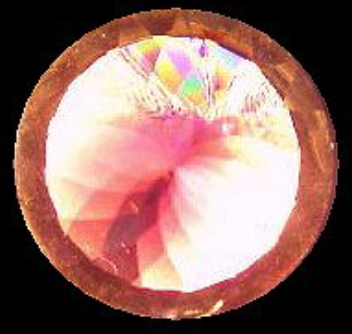Polariscope Guide, Part 2: Testing for Optic Figure and Sign
Learn how to use a polariscope to find the optic figure and sign of a gemstone. This is an important test for gem identification.
6 Minute Read
Finding Interference Colors
Begin by setting the polariscope filters to their darkest position. Rotate the gem between the filters and look for interference colors. These are colors that aren’t normal for the gem and will resemble dispersion or the colors of a soap bubble. If you see them, touch your condensing sphere to the area of brightest color. This will reveal the optic figure.
If you have trouble finding the interference colors, look through the longest direction of the girdle while holding your condensing sphere over the girdle. This is a very small area, so you have to move your hand slowly and look carefully. This technique will often reveal an optic sign even when you can’t see interference colors.
Finding the Isogyre
Another technique is to hold the gem upright, rotate it 360°, and carefully observe the stone through magnification when it blinks from dark to light. You should see a dark shadow, called a brush or isogyre, move across the stone as it changes from dark to light. If the entire stone changes all at once, you’re looking straight down the optic axis. Test the gem again, this time from the side or end, until you see the…
Donald Clark, CSM IMG
Donald Clark, CSM founded the International Gem Society in 1998. Donald started in the gem and jewelry industry in 1976. He received his formal gemology training from the Gemological Institute of America (GIA) and the American Society of Gemcutters (ASG). The letters “CSM” after his name stood for Certified Supreme Master Gemcutter, a designation of Wykoff’s ASG which has often been referred to as the doctorate of gem cutting. The American Society of Gemcutters only had 54 people reach this level. Along with dozens of articles for leading trade magazines, Donald authored the book “Modern Faceting, the Easy Way.”
Related Articles
Learn to Use a Polariscope (Video)
The Spectroscope
Color Filters: Uses and Limitations for Gemology
Gemology Reference Books: Reviews
Latest Articles
800 Years of Mogok: A Celebration in Tenuous Times
What is the Average Gemstone Faceting Yield?
Pyroxmangite Value, Price, and Jewelry Information
How to Identify Emerald Simulants and Synthetics
Never Stop Learning
When you join the IGS community, you get trusted diamond & gemstone information when you need it.
Get Gemology Insights
Get started with the International Gem Society’s free guide to gemstone identification. Join our weekly newsletter & get a free copy of the Gem ID Checklist!
